instrument panel FIAT TALENTO 2017 Owner handbook (in English)
[x] Cancel search | Manufacturer: FIAT, Model Year: 2017, Model line: TALENTO, Model: FIAT TALENTO 2017Pages: 228, PDF Size: 4.47 MB
Page 38 of 228
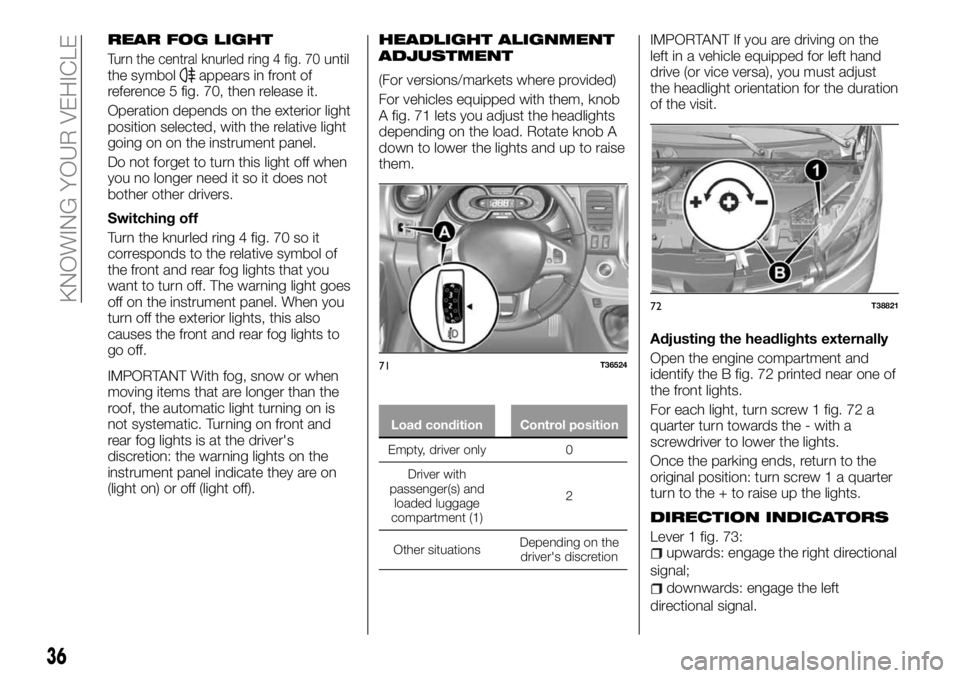
REAR FOG LIGHT
Turn the central knurled ring 4 fig. 70until
the symbolappears in front of
reference 5 fig. 70, then release it.
Operation depends on the exterior light
position selected, with the relative light
going on on the instrument panel.
Do not forget to turn this light off when
you no longer need it so it does not
bother other drivers.
Switching off
Turn the knurled ring 4 fig. 70 so it
corresponds to the relative symbol of
the front and rear fog lights that you
want to turn off. The warning light goes
off on the instrument panel. When you
turn off the exterior lights, this also
causes the front and rear fog lights to
go off.
IMPORTANT With fog, snow or when
moving items that are longer than the
roof, the automatic light turning on is
not systematic. Turning on front and
rear fog lights is at the driver's
discretion: the warning lights on the
instrument panel indicate they are on
(light on) or off (light off).
HEADLIGHT ALIGNMENT
ADJUSTMENT
(For versions/markets where provided)
For vehicles equipped with them, knob
A fig. 71 lets you adjust the headlights
depending on the load. Rotate knob A
down to lower the lights and up to raise
them.
Load condition Control position
Empty, driver only 0
Driver
with
passenger(s) and
loaded luggage
compartment (1)2
Other situationsDepending on the
driver's discretion
IMPORTANT If you are driving on the
left in a vehicle equipped for left hand
drive (or vice versa), you must adjust
the headlight orientation for the duration
of the visit.
Adjusting the headlights externally
Open the engine compartment and
identify the B fig. 72 printed near one of
the front lights.
For each light, turn screw 1 fig. 72 a
quarter turn towards the - with a
screwdriver to lower the lights.
Once the parking ends, return to the
original position: turn screw 1 a quarter
turn to the + to raise up the lights.
DIRECTION INDICATORS
Lever 1 fig. 73:upwards: engage the right directional
signal;
downwards: engage the left
directional signal.
71T36524
72T38821
36
KNOWING YOUR VEHICLE
Page 45 of 228
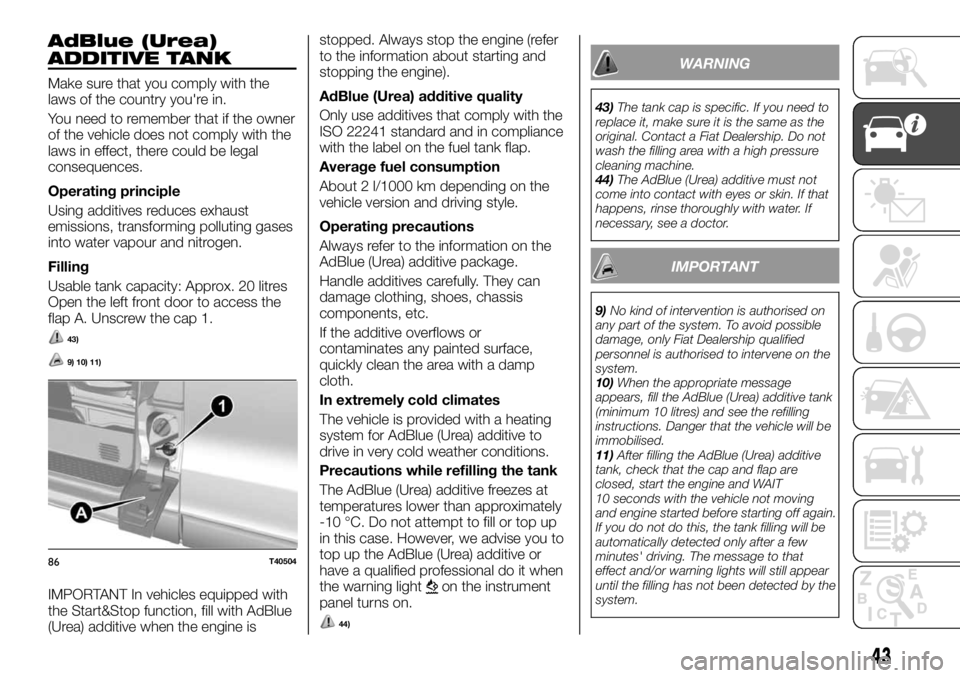
AdBlue (Urea)
ADDITIVE TANK
Make sure that you comply with the
laws of the country you're in.
You need to remember that if the owner
of the vehicle does not comply with the
laws in effect, there could be legal
consequences.
Operating principle
Using additives reduces exhaust
emissions, transforming polluting gases
into water vapour and nitrogen.
Filling
Usable tank capacity: Approx. 20 litres
Open the left front door to access the
flap A. Unscrew the cap 1.
43)
9) 10) 11)
IMPORTANT In vehicles equipped with
the Start&Stop function, fill with AdBlue
(Urea) additive when the engine isstopped. Always stop the engine (refer
to the information about starting and
stopping the engine).
AdBlue (Urea) additive quality
Only use additives that comply with the
ISO 22241 standard and in compliance
with the label on the fuel tank flap.
Average fuel consumption
About 2 l/1000 km depending on the
vehicle version and driving style.
Operating precautions
Always refer to the information on the
AdBlue (Urea) additive package.
Handle additives carefully. They can
damage clothing, shoes, chassis
components, etc.
If the additive overflows or
contaminates any painted surface,
quickly clean the area with a damp
cloth.
In extremely cold climates
The vehicle is provided with a heating
system for AdBlue (Urea) additive to
drive in very cold weather conditions.
Precautions while refilling the tank
The AdBlue (Urea) additive freezes at
temperatures lower than approximately
-10 °C. Do not attempt to fill or top up
in this case. However, we advise you to
top up the AdBlue (Urea) additive or
have a qualified professional do it when
the warning lighton the instrument
panel turns on.
44)
WARNING
43)The tank cap is specific. If you need to
replace it, make sure it is the same as the
original. Contact a Fiat Dealership. Do not
wash the filling area with a high pressure
cleaning machine.
44)The AdBlue (Urea) additive must not
come into contact with eyes or skin. If that
happens, rinse thoroughly with water. If
necessary, see a doctor.
IMPORTANT
9)No kind of intervention is authorised on
any part of the system. To avoid possible
damage, only Fiat Dealership qualified
personnel is authorised to intervene on the
system.
10)When the appropriate message
appears, fill the AdBlue (Urea) additive tank
(minimum 10 litres) and see the refilling
instructions. Danger that the vehicle will be
immobilised.
11)After filling the AdBlue (Urea) additive
tank, check that the cap and flap are
closed, start the engine and WAIT
10 seconds with the vehicle not moving
and engine started before starting off again.
If you do not do this, the tank filling will be
automatically detected only after a few
minutes' driving. The message to that
effect and/or warning lights will still appear
until the filling has not been detected by the
system.
86T40504
43
Page 48 of 228
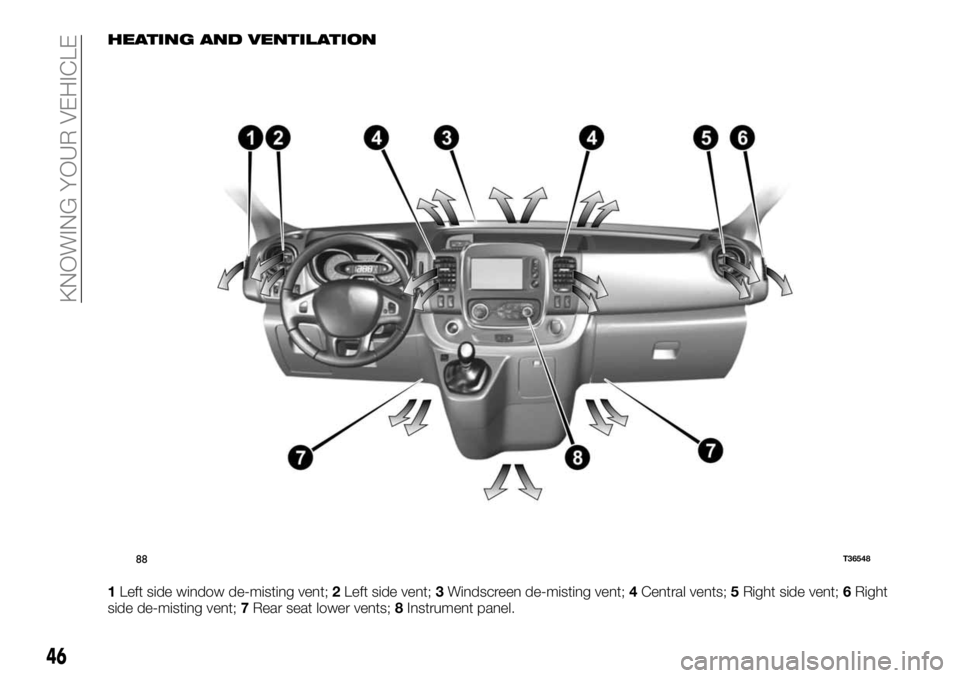
HEATING AND VENTILATION
1Left side window de-misting vent;2Left side vent;3Windscreen de-misting vent;4Central vents;5Right side vent;6Right
side de-misting vent;7Rear seat lower vents;8Instrument panel.
88T36548
46
KNOWING YOUR VEHICLE
Page 57 of 228
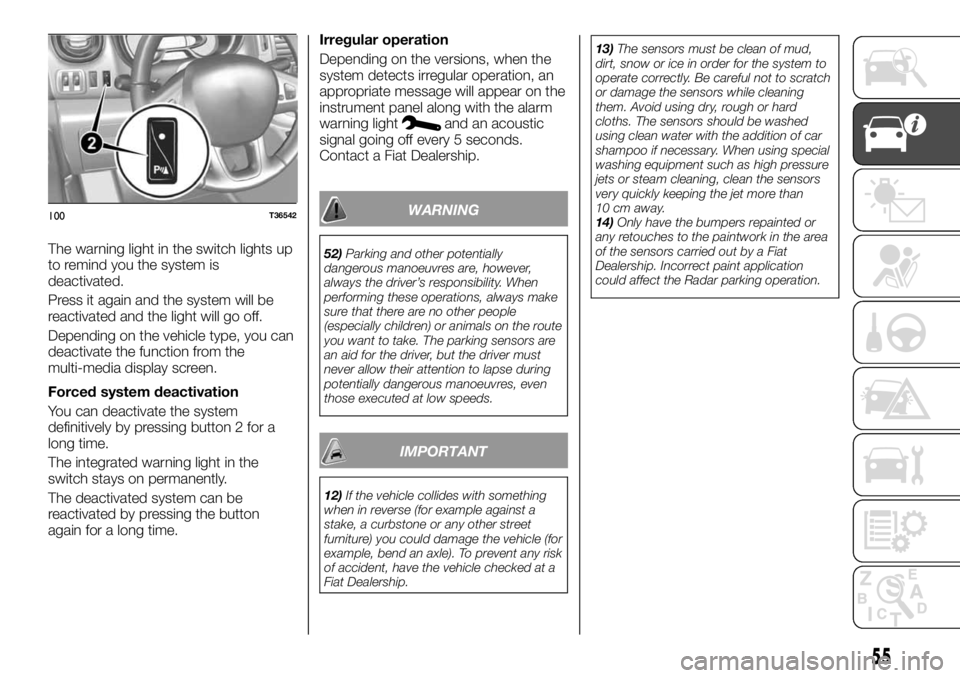
The warning light in the switch lights up
to remind you the system is
deactivated.
Press it again and the system will be
reactivated and the light will go off.
Depending on the vehicle type, you can
deactivate the function from the
multi-media display screen.
Forced system deactivation
You can deactivate the system
definitively by pressing button 2 for a
long time.
The integrated warning light in the
switch stays on permanently.
The deactivated system can be
reactivated by pressing the button
again for a long time.Irregular operation
Depending on the versions, when the
system detects irregular operation, an
appropriate message will appear on the
instrument panel along with the alarm
warning light
and an acoustic
signal going off every 5 seconds.
Contact a Fiat Dealership.
WARNING
52)Parking and other potentially
dangerous manoeuvres are, however,
always the driver’s responsibility. When
performing these operations, always make
sure that there are no other people
(especially children) or animals on the route
you want to take. The parking sensors are
an aid for the driver, but the driver must
never allow their attention to lapse during
potentially dangerous manoeuvres, even
those executed at low speeds.
IMPORTANT
12)If the vehicle collides with something
when in reverse (for example against a
stake, a curbstone or any other street
furniture) you could damage the vehicle (for
example, bend an axle). To prevent any risk
of accident, have the vehicle checked at a
Fiat Dealership.13)The sensors must be clean of mud,
dirt, snow or ice in order for the system to
operate correctly. Be careful not to scratch
or damage the sensors while cleaning
them. Avoid using dry, rough or hard
cloths. The sensors should be washed
using clean water with the addition of car
shampoo if necessary. When using special
washing equipment such as high pressure
jets or steam cleaning, clean the sensors
very quickly keeping the jet more than
10 cm away.
14)Only have the bumpers repainted or
any retouches to the paintwork in the area
of the sensors carried out by a Fiat
Dealership. Incorrect paint application
could affect the Radar parking operation.
100T36542
55
Page 63 of 228
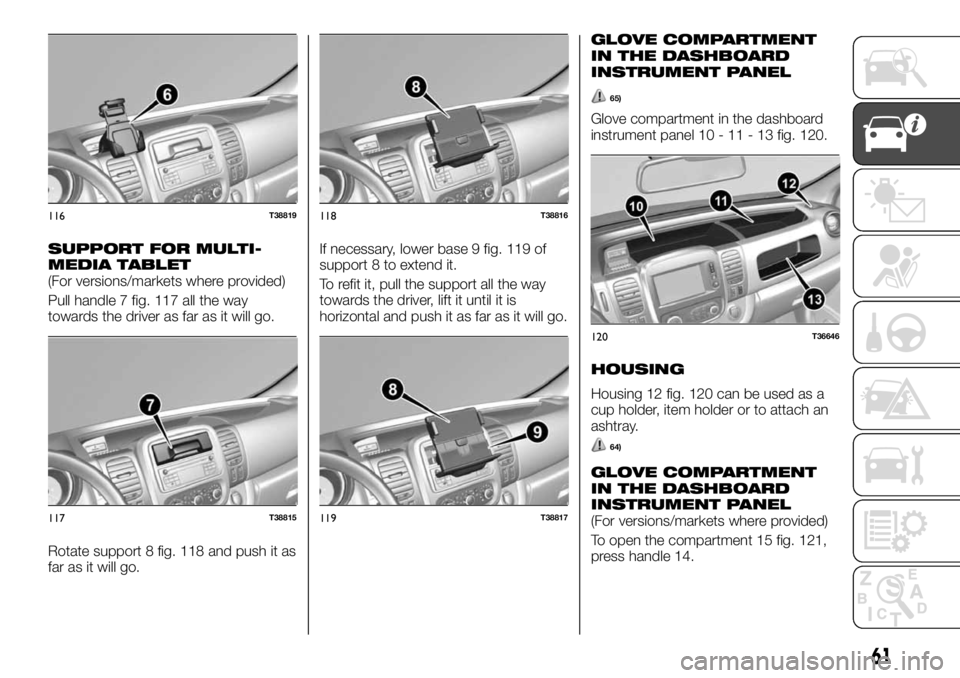
SUPPORT FOR MULTI-
MEDIA TABLET
(For versions/markets where provided)
Pull handle 7 fig. 117 all the way
towards the driver as far as it will go.
Rotate support 8 fig. 118 and push it as
far as it will go.If necessary, lower base 9 fig. 119 of
support 8 to extend it.
To refit it, pull the support all the way
towards the driver, lift it until it is
horizontal and push it as far as it will go.
GLOVE COMPARTMENT
IN THE DASHBOARD
INSTRUMENT PANEL
65)
Glove compartment in the dashboard
instrument panel 10 - 11 - 13 fig. 120.
HOUSING
Housing 12 fig. 120 can be used as a
cup holder, item holder or to attach an
ashtray.
64)
GLOVE COMPARTMENT
IN THE DASHBOARD
INSTRUMENT PANEL
(For versions/markets where provided)
To open the compartment 15 fig. 121,
press handle 14.
116T38819
117T38815
118T38816
119T38817
120T36646
61
Page 70 of 228
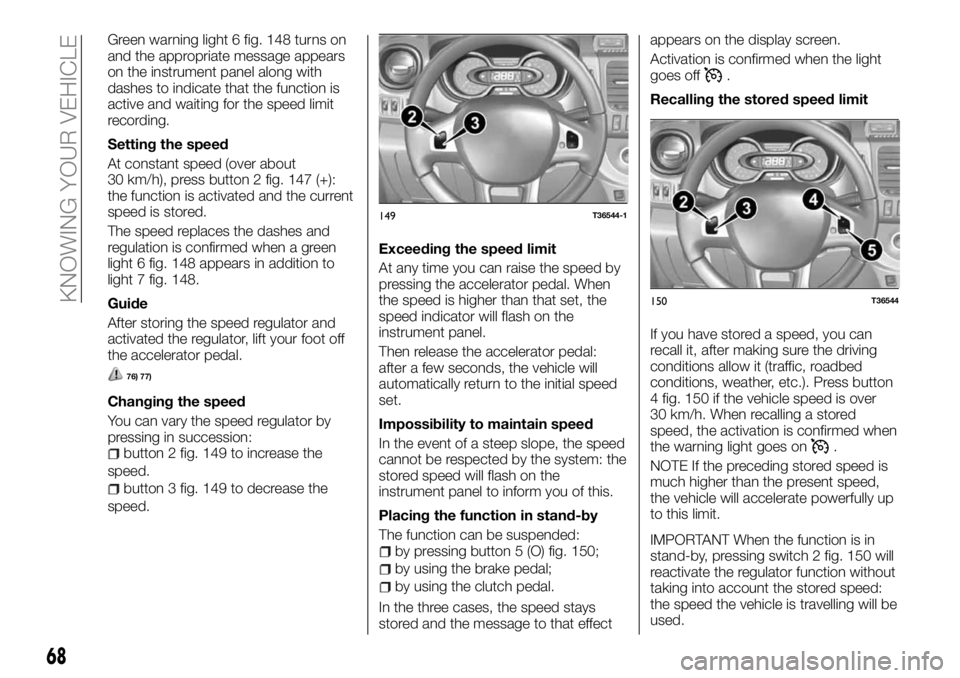
Green warning light 6 fig. 148 turns on
and the appropriate message appears
on the instrument panel along with
dashes to indicate that the function is
active and waiting for the speed limit
recording.
Setting the speed
At constant speed (over about
30 km/h), press button 2 fig. 147 (+):
the function is activated and the current
speed is stored.
The speed replaces the dashes and
regulation is confirmed when a green
light 6 fig. 148 appears in addition to
light 7 fig. 148.
Guide
After storing the speed regulator and
activated the regulator, lift your foot off
the accelerator pedal.
76) 77)
Changing the speed
You can vary the speed regulator by
pressing in succession:
button 2 fig. 149 to increase the
speed.
button 3 fig. 149 to decrease the
speed.Exceeding the speed limit
At any time you can raise the speed by
pressing the accelerator pedal. When
the speed is higher than that set, the
speed indicator will flash on the
instrument panel.
Then release the accelerator pedal:
after a few seconds, the vehicle will
automatically return to the initial speed
set.
Impossibility to maintain speed
In the event of a steep slope, the speed
cannot be respected by the system: the
stored speed will flash on the
instrument panel to inform you of this.
Placing the function in stand-by
The function can be suspended:
by pressing button 5 (O) fig. 150;
by using the brake pedal;
by using the clutch pedal.
In the three cases, the speed stays
stored and the message to that effectappears on the display screen.
Activation is confirmed when the light
goes off
.
Recalling the stored speed limit
If you have stored a speed, you can
recall it, after making sure the driving
conditions allow it (traffic, roadbed
conditions, weather, etc.). Press button
4 fig. 150 if the vehicle speed is over
30 km/h. When recalling a stored
speed, the activation is confirmed when
the warning light goes on
.
NOTE If the preceding stored speed is
much higher than the present speed,
the vehicle will accelerate powerfully up
to this limit.
IMPORTANT When the function is in
stand-by, pressing switch 2 fig. 150 will
reactivate the regulator function without
taking into account the stored speed:
the speed the vehicle is travelling will be
used.
149T36544-1
150T36544
68
KNOWING YOUR VEHICLE
Page 71 of 228
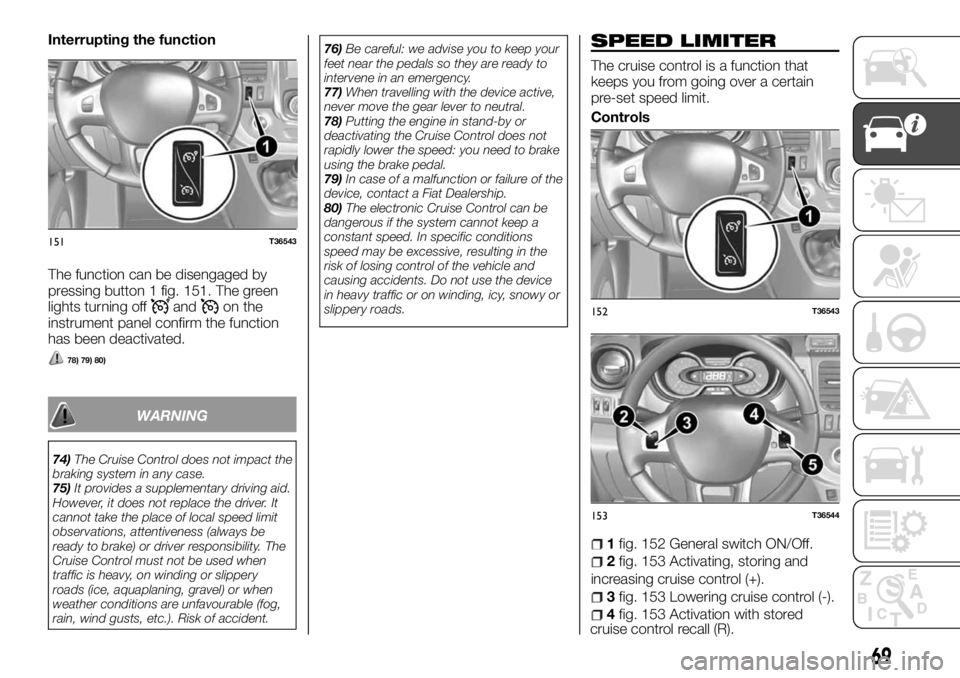
Interrupting the function
The function can be disengaged by
pressing button 1 fig. 151. The green
lights turning off
andon the
instrument panel confirm the function
has been deactivated.
78) 79) 80)
WARNING
74)The Cruise Control does not impact the
braking system in any case.
75)It provides a supplementary driving aid.
However, it does not replace the driver. It
cannot take the place of local speed limit
observations, attentiveness (always be
ready to brake) or driver responsibility. The
Cruise Control must not be used when
traffic is heavy, on winding or slippery
roads (ice, aquaplaning, gravel) or when
weather conditions are unfavourable (fog,
rain, wind gusts, etc.). Risk of accident.76)Be careful: we advise you to keep your
feet near the pedals so they are ready to
intervene in an emergency.
77)When travelling with the device active,
never move the gear lever to neutral.
78)Putting the engine in stand-by or
deactivating the Cruise Control does not
rapidly lower the speed: you need to brake
using the brake pedal.
79)In case of a malfunction or failure of the
device, contact a Fiat Dealership.
80)The electronic Cruise Control can be
dangerous if the system cannot keep a
constant speed. In specific conditions
speed may be excessive, resulting in the
risk of losing control of the vehicle and
causing accidents. Do not use the device
in heavy traffic or on winding, icy, snowy or
slippery roads.
SPEED LIMITER
The cruise control is a function that
keeps you from going over a certain
pre-set speed limit.
Controls
1fig. 152 General switch ON/Off.
2fig. 153 Activating, storing and
increasing cruise control (+).
3fig. 153 Lowering cruise control (-).
4fig. 153 Activation with stored
151T36543
152T36543
153T36544
69
cruise control recall (R).
Page 72 of 228
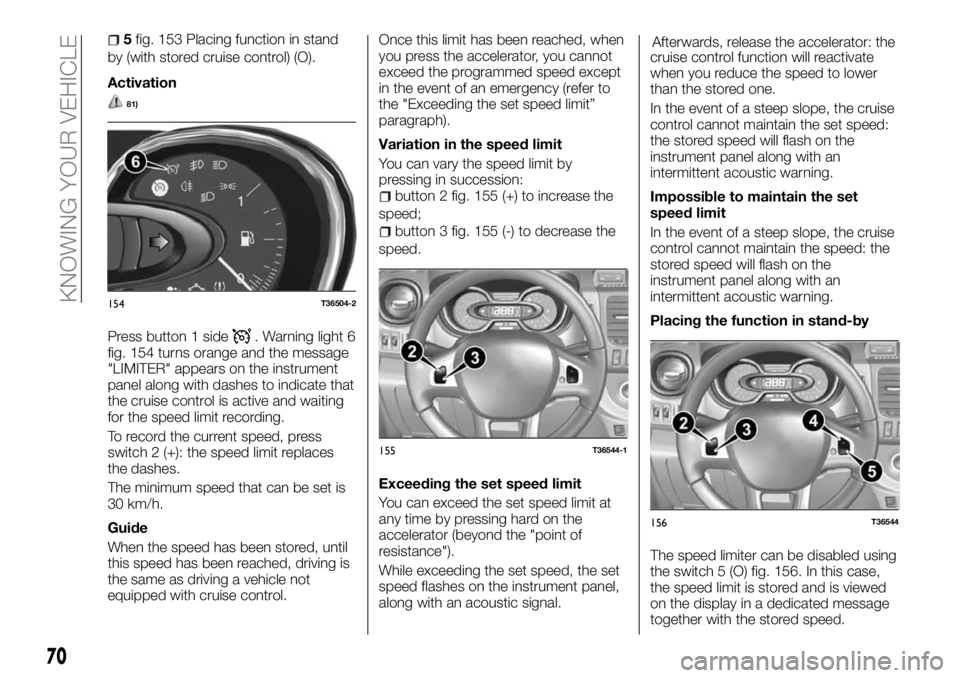
5fig. 153 Placing function in stand
by (with stored cruise control) (O).
Activation
81)
Press button 1 side. Warning light 6
fig. 154 turns orange and the message
"LIMITER" appears on the instrument
panel along with dashes to indicate that
the cruise control is active and waiting
for the speed limit recording.
To record the current speed, press
switch 2 (+): the speed limit replaces
the dashes.
The minimum speed that can be set is
30 km/h.
Guide
When the speed has been stored, until
this speed has been reached, driving is
the same as driving a vehicle not
equipped with cruise control.Once this limit has been reached, when
you press the accelerator, you cannot
exceed the programmed speed except
in the event of an emergency (refer to
the "Exceeding the set speed limit”
paragraph).
Variation in the speed limit
You can vary the speed limit by
pressing in succession:
button 2 fig. 155 (+) to increase the
speed;
button 3 fig. 155 (-) to decrease the
speed.
Exceeding the set speed limit
You can exceed the set speed limit at
any time by pressing hard on the
accelerator (beyond the "point of
resistance").
While exceeding the set speed, the set
speed flashes on the instrument panel,
along with an acoustic signal.Afterwards, release the accelerator: the
cruise control function will reactivate
when you reduce the speed to lower
than the stored one.
In the event of a steep slope, the cruise
control cannot maintain the set speed:
the stored speed will flash on the
instrument panel along with an
intermittent acoustic warning.
Impossible to maintain the set
speed limit
In the event of a steep slope, the cruise
control cannot maintain the speed: the
stored speed will flash on the
instrument panel along with an
intermittent acoustic warning.
Placing the function in stand-by
The speed limiter can be disabled using
the switch 5 (O) fig. 156. In this case,
the speed limit is stored and is viewed
on the display in a dedicated message
together with the stored speed.
154T36504-2
155T36544-1
156T36544
70
KNOWING YOUR VEHICLE
Page 73 of 228
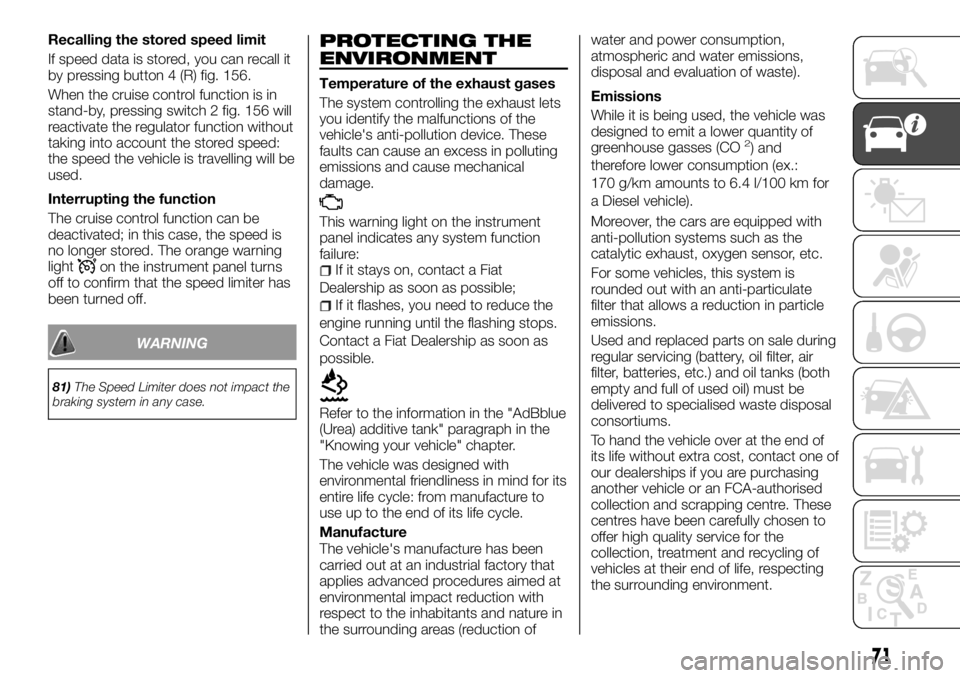
Recalling the stored speed limit
If speed data is stored, you can recall it
by pressing button 4 (R) fig. 156.
When the cruise control function is in
stand-by, pressing switch 2 fig. 156 will
reactivate the regulator function without
taking into account the stored speed:
the speed the vehicle is travelling will be
used.
Interrupting the function
The cruise control function can be
deactivated; in this case, the speed is
no longer stored. The orange warning
light
on the instrument panel turns
off to confirm that the speed limiter has
been turned off.
WARNING
81)The Speed Limiter does not impact the
braking system in any case.
PROTECTING THE
ENVIRONMENT
Temperature of the exhaust gases
The system controlling the exhaust lets
you identify the malfunctions of the
vehicle's anti-pollution device. These
faults can cause an excess in polluting
emissions and cause mechanical
damage.
This warning light on the instrument
panel indicates any system function
failure:
If it stays on, contact a Fiat
Dealership as soon as possible;
If it flashes, you need to reduce the
engine running until the flashing stops.
Contact a Fiat Dealership as soon as
possible.
Refer to the information in the "AdBblue
(Urea) additive tank" paragraph in the
"Knowing your vehicle" chapter.
The vehicle was designed with
environmental friendliness in mind for its
entire life cycle: from manufacture to
use up to the end of its life cycle.
Manufacture
The vehicle's manufacture has been
carried out at an industrial factory that
applies advanced procedures aimed at
environmental impact reduction with
respect to the inhabitants and nature in
the surrounding areas (reduction ofwater and power consumption,
atmospheric and water emissions,
disposal and evaluation of waste).
Emissions
While it is being used, the vehicle was
designed to emit a lower quantity of
greenhouse gasses (CO
2) and
therefore lower consumption (ex.:
170 g/km amounts to 6.4 l/100 km for
a Diesel vehicle).
Moreover, the cars are equipped with
anti-pollution systems such as the
catalytic exhaust, oxygen sensor, etc.
For some vehicles, this system is
rounded out with an anti-particulate
filter that allows a reduction in particle
emissions.
Used and replaced parts on sale during
regular servicing (battery, oil filter, air
filter, batteries, etc.) and oil tanks (both
empty and full of used oil) must be
delivered to specialised waste disposal
consortiums.
To hand the vehicle over at the end of
its life without extra cost, contact one of
our dealerships if you are purchasing
another vehicle or an FCA-authorised
collection and scrapping centre. These
centres have been carefully chosen to
offer high quality service for the
collection, treatment and recycling of
vehicles at their end of life, respecting
the surrounding environment.
71
Page 75 of 228
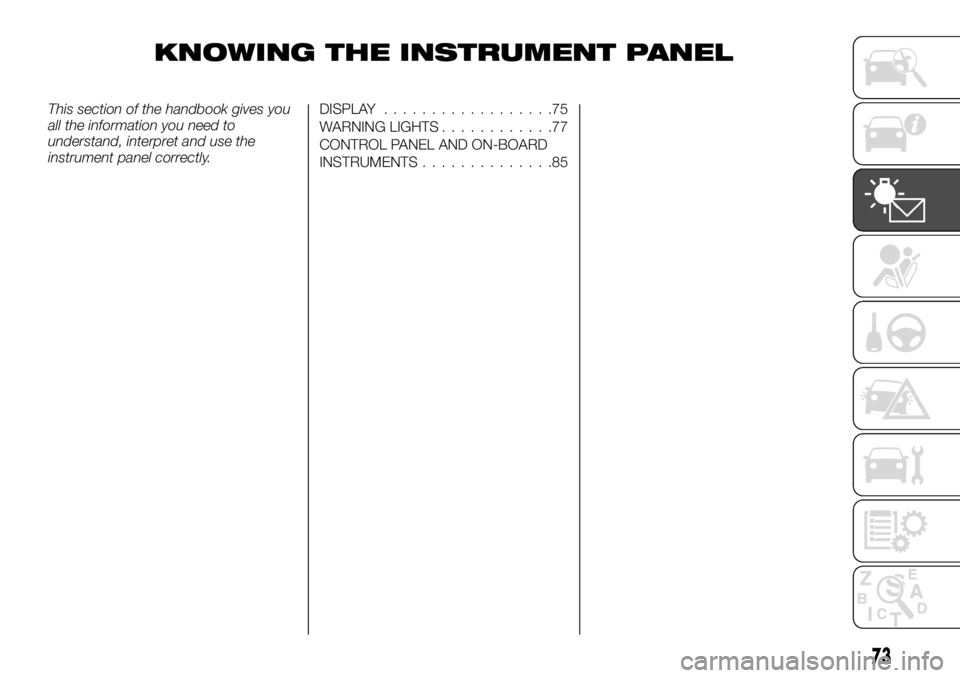
KNOWING THE INSTRUMENT PANEL
This section of the handbook gives you
all the information you need to
understand, interpret and use the
instrument panel correctly.DISPLAY..................75
WARNING LIGHTS............77
CONTROL PANEL AND ON-BOARD
INSTRUMENTS..............85
73